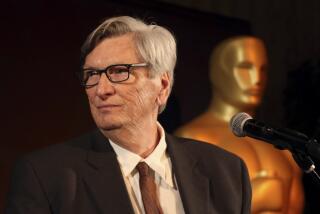Movie review: âOn the Boweryâ
âOn the Boweryâ may be more than half a century old, but it is no relic. This landmark documentary disturbs and compels as much today in a new 35mm restoration as it did when it opened in 1956 to both criticism and acclaim.
Though only 65 minutes long, the story of three days spent in the heart of New Yorkâs infamous skid row (characterized by a rescue mission minister as âthe saddest and maddest street in the worldâ) unnerved some critics with its rough-edged rawness but also captured numerous awards, including an Oscar nomination, a British Academy Award and the Venice Film Festival documentary grand prize.
Lionel Rogosin was influenced by pioneer documentarian Robert Flaherty (âNanook of the North,â âMan of Aranâ) as well as such groundbreaking Italian neorealist films as âThe Bicycle Thief.â But âBoweryâsâ producer-director forged his own path to reflecting reality that is quite different from what doc filmmakers do today.
First, Rogosin spent a full six months on the Bowery, the once-downtrodden Manhattan neighborhood where rootless men (and a few women) lurched around in the shadows of the since-demolished Third Avenue El with only one aim: how to find or finance their next drink.
Once he started shooting, Rogosinâs goals, he wrote, were âto film those who have been forgotten, to film from the inside, and to film with respect, clarity and tenderness,â all of which he succeeded in doing.
To this end, the director took a two-fold approach. In line with Flahertyâs earlier work, he selected a handful of alcoholics heâd met during his months of research and constructed a story around their lives and personalities, a story that he then filmed in a quasi-improvisational style with these men as his stars.
This story was set against more classic cinĂŠma vĂŠritĂŠ-type documentary footage of life on the Bowery, footage that was shot in beautiful black and white (at times with a concealed camera) by cinematographer Richard Bagley.
Bagley was not only an accomplished cameraman, but he was also quite a heavy drinker himself, and it is possible to feel genuine empathy in his shots of the Boweryâs harsh realities: men staggering around in alcoholic dazes, passed out on the sidewalks in complete stupors, screaming savage vituperation at one another in the crazed arguments that were nightly occurrences at the Bedlam-like local bars.
Into this pungent atmosphere, Rogosin introduced his two main characters. First comes Ray Salyer, newly arrived on the Bowery after a stint working on the railroad. Movie-star handsome in a Gary Cooper way, Ray is so eager for a drink that he hits the bars suitcase in hand as soon as he gets to town.
Ray soon makes the acquaintance of one of the Boweryâs older regulars, Gorman Hendricks. Sometimes called Doc because he claims to have once been a doctor as well as a newspaperman, the garrulous Gorman becomes Rayâs guide to this disturbing underworld.
But just because men drink together in bars with names like Round House, Confidence and Arcade, that does not exactly make them classic friends. The characters in âBoweryâ help one another at times, but in their addicted frenzy for drinks theyâre willing to rob and betray as often as they offer assistance. Though the reverend at the Bowery Mission may say âthere are no hopeless cases with God,â Rogosinâs film makes you not so sure.
Because Gorman and Ray are of the Bowery, the film features the genuine talk of the time, people asking for âmuskyâ (short for muscatel) and referring to âsneaky pete,â a pint bottle hidden in a paper bag. There are even shots of Sterno being drained through a handkerchief to produce the deadly beverage known as canned heat.
Yet no matter what it shows them doing, âOn the Boweryâ always offers its subjects what dignity and respect they can achieve. As âThe Perfect Team: The Making of On the Boweryâ â a short documentary playing on the same bill â demonstrates, this film was a true collaboration between filmmakers and subjects.
âOn the Boweryâ is dedicated to Hendricks, who died of cirrhosis after the film was finished but before it was released. As to the charismatic Salyer, he squirmed under the media spotlight focused on him after the film came out, which included some genuine offers to star in dramatic films.
âI just want to be left alone,â he was quoted as saying. âThere is nothing else in life but the booze.â In the midst of everything, he suddenly left New York and was never heard from again. It was a fate that this singular film has thankfully avoided.
More to Read
The biggest entertainment stories
Get our big stories about Hollywood, film, television, music, arts, culture and more right in your inbox as soon as they publish.
You may occasionally receive promotional content from the Los Angeles Times.











